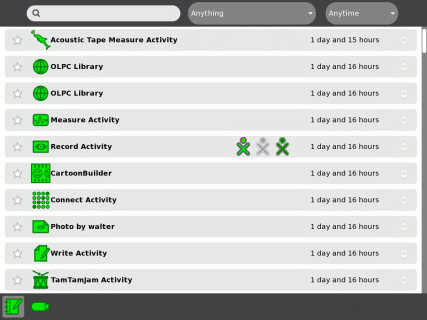USB drive
Image:Support-banner-square.png|173px|community support pages rect 0 0 135 204 [1] rect 135 0 345 204 Support FAQ rect 0 205 135 408 [2]
- Comment : there's some whitespace here:
rect 135 205 345 408 Other support
- maybe desc none is better. testing.
desc none
</imagemap>USB drives include USB flash drives (known as "memory sticks", "USB keys", "thumb drives" or "jump drives") and also larger USB hard drives.
The Sugar Manual and ![]() has more information and graphics to help you.
has more information and graphics to help you.
Using
Insert the USB drive in one of three USB ports on the side of the display of the laptop.
Viewing
Go to the Journal, which you can access from the Home View. Select the notebook icon just below the XO character to open the Journal.
The USB icon ![]() appears in the lower left corner of the display.
appears in the lower left corner of the display.
Click on the USB icon to view the files on the USB drive. Click on the journal icon to return to the journal.
Copying a file from the Journal to the USB drive
- click on the journal icon,
- move the cursor over the Journal item and drag it to the USB icon.
Copying a file from the USB drive to the Journal
- click on the USB icon,
- move the cursor over the USB item and drag it to the journal icon.
Removing the USB drive
Right-click or move the mouse over the USB icon, wait for the menu, and click on "Unmount". Wait for the USB icon to disappear. Pull out the USB drive.
GNOME
A window will appear when a USB drive is inserted. The window will show the contents of the USB drive. An eject icon within the window can be used to safely remove the drive.
Shell
The Journal automatically mounts the USB drive at /run/media/olpc based on the drive's disk label, for example /run/media/olpc/KINGSTON/. You can use Linux commands in the Terminal activity to access its files. For example cp tmp/* /run/media/olpc/My_drives_name
Compatibility
U3
Some USB drives come with the U3 software pre-installed. U3 is software for a Windows PC, and it may prevent successful mounting of the drive on the XO laptop. Further, presence of the U3 software on a drive may cause the XO to incompletely mount the drive, in such a way that even if you can remove the U3 software, the remnants of the incomplete mount will still prevent a successful mount. Re-formatting the USB drive from a Windows computer may remove the U3 software and any remnants of an prior incomplete mount. Further details on disabling the CD-ROM emulation feature can be found on at U3 (Wikipedia).
Open Firmware
The XO's firmware can access a USB drive during boot, for example to upgrade system software or write a new image.
Most USB drives should work.
Some USB drives require features of a complete operating system, and may not work reliably with Open Firmware. You can test compatibility with Open Firmware by using the dir command at the Ok prompt:
ok dir u:\
If this command shows the files on the USB drive, then the combination of (a) Open Firmware version, (b) the USB drive and (c) the filesystem on the drive, is likely to work for upgrading system software or firmware. You should proceed with hope. If an error is displayed by the dir command, then the possible causes are:
- unrecognised partition table, (such as GPT used by Mac OS X),
- unrecognised partition type, (such as HFS+ used by Mac OS X. Partition types known by Open Firmware include ISO9660, FAT12, FAT16, FAT32, ext2, and ext3),
- there are multiple partitions and the first partition is not recognised, (your host operating system may freely access the second partition without knowing about the first partition, resulting in files being copied to the drive fine, but not being visible in Open Firmware),
- the drive is a specialised device such as U3, which asserts that it is a hub with a CD-ROM and mass storage drive attached,
- Open Firmware may need upgrading,
- faulty USB drive,
- faulty laptop.
For a flash drive to be compatible with firmware, make sure it is formatted as FAT, FAT32, ext2, or ext3, and only contains one partition. Most ordinary USB flash drives are set up by factory as FAT or FAT32.
Several USB flash drives were found to be incompatible with older firmware versions. If you have a problem with a USB flash drive in Open Firmware, please make sure you try upgrading firmware.
See also
- How to Damage a FLASH Storage Device is a detailed page telling you how to degrade the performance and reliability of FLASH-based storage devices such as SD cards and USB flash drives. And by implication, how not to damage them.
- Secure Digital card - the XO also has a slot for an SD/SDHC memory card, which you can access from the Journal and Terminal in a similar manner. The XO-1.5 uses an internal microSD card.
- SD and USB FLASH Drive Performance discusses the performance of drives and how to measure them.
